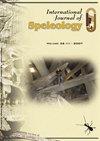Recreational caving impacts of visitors in a high-altitude cave in Bolivian Andes: main effects on microhabitat structure and faunal distribution
IF 1.3
4区 地球科学
Q3 GEOSCIENCES, MULTIDISCIPLINARY
引用次数: 1
Abstract
The cave’s physical environment can be affected by tourism activities but only a few studies evaluated how recreational use may affect the cave fauna, mainly in caves with a low number of visitors per year. To test the hypothesis that recreational use led to changes in habitat structure and invertebrate diversity, distinct scales along a cave were analyzed. Distinct areas with and without human visitation were analyzed and transects (10 x 3 m) and quadrats (1 x 1 m) were used to access the invertebrate communities and environmental traits. Thirty-two invertebrate species were recorded, among which six are troglobitic. The similarity of non- troglobitic species differed between the visited and non-visited areas. Substrate composition inside transects differed between the two areas and the differences were higher in the percentage of matrix rock and fine sediments. The distance from the entrance influenced the similarity of non-troglobitic species while troglobitic fauna responded to the proportion of sandy sediment. Inside quadrats, both matrix rock and fine sediments influenced the similarity of non-troglobitic species. Similarity of non-troglobitic species in the visited area was explained by the proportion of matrix rock in transects and quadrats. The proportion of cobbles influenced the similarity of non-troglobitic species in quadrats in the non-visited area. The non-troglobitic species richness inside quadrants was positively related to the amount of guano, wood, fine sediment, boulders, cobbles, matrix rock, sand sediment, and plant debris. Differentiation in habitat structure and faunal composition between the two areas seems to be an effect of distance from the entrance and spatial heterogeneity, but not recreational activities.玻利维亚安第斯高原高海拔洞穴游客的休闲崩落影响:对微生境结构和动物分布的主要影响
洞穴的自然环境可能会受到旅游活动的影响,但只有少数研究评估了娱乐利用如何影响洞穴动物,主要是在每年游客数量较少的洞穴中。为了验证休闲利用导致栖息地结构和无脊椎动物多样性变化的假设,研究人员分析了沿洞穴的不同尺度。分析了有和没有人类访问的不同区域,并使用样带(10 x 3 m)和样方(1 x 1 m)来获取无脊椎动物群落和环境特征。记录到32种无脊椎动物,其中6种为穴居动物。非穴居物种的相似性在参观区和非参观区之间存在差异。两区样带内的基质组成存在差异,其中基质岩和细粒沉积物的比例差异较大。与入口的距离影响非穴居动物的相似性,而穴居动物的动物群对砂质沉积物的比例有响应。在样方内,基质岩和细粒沉积物都影响非穴居物种的相似性。研究区非穴居物种的相似性可以用样带和样方中基质岩石的比例来解释。鹅卵石的比例影响了未到访区样方中非穴居物种的相似性。象限内非居地物种丰富度与鸟粪、木材、细沉积物、巨石、鹅卵石、基质岩、沙质沉积物和植物碎屑的数量呈正相关。两区生境结构和动物组成的差异主要受入口距离和空间异质性的影响,而非游憩活动的影响。
本文章由计算机程序翻译,如有差异,请以英文原文为准。
求助全文
约1分钟内获得全文
求助全文
来源期刊

International Journal of Speleology
地学-地球科学综合
CiteScore
3.10
自引率
23.10%
发文量
12
审稿时长
>12 weeks
期刊介绍:
The International Journal of Speleology has the aim to get cave and karst science known to an increasing number of scientists and scholars. The journal therefore offers the opportunity to all scientists working in and on karst to publish their original research articles or their review papers in an open access, high quality peer reviewed scientific journal at no cost. The journal offers the authors online first, open access, a free PDF of their article, and a wide range of abstracting and indexing services.
 求助内容:
求助内容: 应助结果提醒方式:
应助结果提醒方式:


